Review of Legal Aspects of Electrical Power Quality in Ship Systems in the Wake of the Novelisation and Implementation of IACS Rules and Requirement
Abstract
1. Introduction
2. Reasons for Legislative Changes
3. Updated IACS Rules and a Related DNV GL Case Study
4. Authors’ Proposals and Future Works
4.1. Harmonics, Subharmonics, and Interharmonics
4.2. Distortion Indices
- TWD up to the 100th harmonic frequency range or 10 kHz, TWD2.5–10 kHz, TIHD up to the 50th harmonic frequency range;
- THD up to 50th harmonic frequency range, TWD2.5–10 kHz, TIHD up to the 50th harmonic frequency range.
4.3. Transient Disturbances
5. Discussion and Conclusions
- TWD up to 100th harmonic frequency range or 10 kHz, TWD2.5–10 kHz, TIHD up to 50th harmonic frequency range;
- THD up to 50th harmonic frequency range, TWD2.5–10 kHz, TIHD up to 50th harmonic frequency range.
Author Contributions
Funding
Institutional Review Board Statement
Informed Consent Statement
Data Availability Statement
Acknowledgments
Conflicts of Interest
References
- Mindykowski, J.; Tarasiuk, T. Problems of power quality in the wake of ship technology development. Ocean. Eng. 2015, 107, 108–117. [Google Scholar] [CrossRef]
- Electromagnetic Compatibility (EMC)—Part 4–30: Testing and Measurement Techniques—Power Quality Measurement Methods; IEC: Geneva, Switzerland, 2015.
- Electrical Installations in Ships—Part 101: Definitions and General Requirements; IEC: Geneva, Switzerland, 2018; Standard 60092-101.
- Requirements Concerning Electrical and Electronic Installations; International Association of Classification Societies IACS Req.: Hamburg, Germany, 2019.
- Part 4 Vessel systems and machinery. In Rules for Building and Classing Steel Vessels; American Bureau of Shipping ABS: Houston, TX, USA, 2019.
- Rules for Classification: Ships. Part 4 Systems and Components. Chapter 8 Electrical Installations; July 2019 ed., Amended October 2019; DNV GL: Høvik, Norway, 2019.
- Rules and Regulations for the Classification of Ships; Lloyd’s Register of Shipping: London, UK, 2019.
- Kumar, D.; Zare, F. Comprehensive review of maritime microgrids: System architectures, energy efficiency, power—Quality and regulations. IEEE Access 2019, 7, 1–11. [Google Scholar] [CrossRef]
- Mindykowski, J. Contemporary challenges to power quality in ship systems—metrological perspective. In Proceedings of the 22nd IMEKO TC4 International Symposium 20th, International Workshop on ADC Modelling and Testing, Iasi, Romania, 14–15 September 2017; pp. 536–558. [Google Scholar]
- Tarasiuk, T. Angular frequency variations at microgrids and its impact on measuring instrument performance. IET Gener. Transm. Distrib. 2016, 10, 3234–3240. [Google Scholar] [CrossRef]
- Gnaciński, P.; Tarasiuk, T.; Mindykowski, J.; Pepliński, M.; Górniak, M.; Hallmann, D.; Piłat, A. Power quality and energy Efficient operation of marine induction motors. IEEE Access 2020, 8, 152193–152203. [Google Scholar] [CrossRef]
- Tarasiuk, T.; Zunino, Y.; Bruno-Lopez, M.; Silvestro, F.; Piłat, A.; Molinas, M. Frequency fluctuations in marine microgrids: Origins and identification tools. IEEE Electrif. Mag. 2020, 8, 40–46. [Google Scholar] [CrossRef]
- Tarasiuk, T.; Górniak, M. Load sharing in ship microgrids under nonsinusoidal conditions—Case study. IEEE Trans. Energy Convers. 2017, 32, 810–819. [Google Scholar] [CrossRef]
- Tarasiuk, T.; Górniak, M.; Liu, W.; Savagheli, M.; Vasquez, J.C.; Chun-Lien, S.; Guerrero, J.M. Power quality assessment in shipboard microgrids under unbalanced and harmonic AC bus voltage. IEEE Trans. Ind. Appl. 2019, 55, 765–775. [Google Scholar]
- Mindykowski, J. Case study—Based overview of some contemporary challenges to power quality in ship systems. Inventions 2016, 1, 12. [Google Scholar] [CrossRef]
- Requirements Concerning Electrical and Electronic Installations, Harmonic Distortions for Ship Electrical Distribution System Including Harmonic Filters; June 2016, Rev.1 December 2018; International Association of Classification Societies, IACS UR E24: Hamburg, Germany, 2018.
- Mindykowski, J. Impact of staff competences on power quality—Related ship accidents. In Proceedings of the 2018 International Conference and Exposition on Electrical and Power Engineering, Iasi, Romania, 1–6 October 2018. [Google Scholar]
- Łozowicka, D.; Kaup, M. Analysis of the cause and effect of passenger ship accidents in the Baltic Sea. Sci. J. Marit. Univ. Szczec. 2015, 44, 68–73. [Google Scholar]
- Ugurlu, O.; Yildiz, S.; Loughney, S.; Wang, J. Modified human factor analysis and classification system for passenger vessel accidents (HFACS-PV). Ocean. Eng. 2018, 161, 47–61. [Google Scholar] [CrossRef]
- Mazaheri, A.; Montewka, J.; Nisula, J.; Kujala, P. Usability of accident and incident reports for evidence–based risk modelling—A case study on ship grounding reports. Saf. Sci. 2015, 76, 202–221. [Google Scholar] [CrossRef]
- Chavin, C.; Lardiane, S.; Morel, G.; Clostermann, J.; Langard, B. Human and organizational factors in maritime accidents: Analysis of collisions at sea using the HFACS. Accid. Anal. Prev. 2013, 59, 26–37. [Google Scholar] [CrossRef]
- Marine Accident Investigation Branch. Report of the Investigation of the Catastrophic Failure of a Capacitor in the Aft Harmonic Filter Room on Board RMS Queen Mary 2 While Approaching Barcelona on 23 September 2010; Marine Accident Investigation Branch: Southampton, UK, December 2011. Available online: http://www.maib.gov.uk/publications/investigation_reports/2011/qm2.cfm (accessed on 31 March 2021).
- Transportation Safety Board of Canada. Marine Investigation Report MO2W0135 Switchboard Fire, Passenger Vessel “Statendam”, Strait of Georgia, British Columbia 04 August 2002; Transportation Safety Board, Minister of Public Works Government Services: Canada, 2005; Available online: https://tsb.gc.ca/eng/rapports-reports/marine/2002/m02w0135/m02w0135.pdf (accessed on 31 March 2021).
- Fire alert on North Sea Platform; Website Publication: Sumburgh, Scotland, 2006; Available online: http://news.bbc.co.uk/2/hi/uk_news/scotland/4811538.stm (accessed on 31 March 2021).
- Evans, I.C. The perils of offshore power quality. Offshore Eng. 2014, 56–59. Available online: https://www.oedigital.com/news/444795-the-perils-of-offshore-power-quality (accessed on 24 May 2021).
- Zhang, W.; Yan, X.; Zhang, D.; Zhang, J. Evaluating the probability of power loss in ship electric propulsion system based on Bayesian belief networks. Mar. Technol. Soc. J. 2019, 53, 1–17. [Google Scholar] [CrossRef]
- Maritime and Coastguard Agency; Draft Marine Guidance Note (MGN). Potential Hazards of Excessive Harmonic Distortion of Current and Voltage of Onboard Electrical Systems; Maritime and Coastguard Agency: Southampton, UK, 2010. [Google Scholar]
- International Maritime Organization. IMO International Convention on Standards of Training, Certification and Watchkeeping for Seafarers, including Manila Amendments, STCW Convention and STCW Code; International Maritime Organization: London, UK, 2011. [Google Scholar]
- Evans, I.C. High frequency harmonics and marine power quality. Mot. Ship 2019, 1–5. Available online: https://www.motorship.com/news101/industry-news/high-frequency-harmonics-and-marine-power-quality (accessed on 24 May 2021).
- Evans, I.C. The future is electric—Let us safeguard it. Mot. Ship 2020, 1–5. Available online: https://www.motorship.com/news101/monitoring,-control-and-digitalization/the-future-is-electric-let-us-safeguard-it (accessed on 24 May 2021).
- Mindykowski, J. Towards safety improvement: Implementation and assessment of new standards of competence for electro-technical officers on ships. Marit. Policy Manag. 2017, 44, 336–357. [Google Scholar] [CrossRef]
- IEEE Recommended Practice for Electrical Installations on Shipboard-Design; IEEE: Piscataway, NJ, USA, 2017; p. 45.1.
- Testa, A.; Akram, M.F.; Burch, R.; Carpinelli, G.; Chang, G.; Dinavahi, V.; Hatziadoniu, C.; Grady, W.M.; Gunther, E.; Halpin, M.; et al. Interharmonics: Theory and modeling. IEEE Trans. Power Deliv. 2007, 22, 2335–2348. [Google Scholar] [CrossRef]
- Nassif, A.B. Assessing the impact of harmonics and interharmonics of top and mudpump variable frequency drives in drilling rigs. IEEE Trans. Ind. Appl. 2019, 55, 5574–5583. [Google Scholar] [CrossRef]
- Arkkio, A.; Cederström, S.; Awan, H.A.A.; Saarakkala, S.E.; Holopainen, T.P. Additional losses of electrical machines under torsional vibration. IEEE Trans. Energy Convers. 2018, 33, 245–251. [Google Scholar] [CrossRef]
- Zhiyuan, M.; Xiong, M.W.; Le, L.; Zhong, X. Interharmonics analysis of a 7.5 kW air compressor motor. CIRED Open Access Proc. J. 2017, 2017, 738–741. [Google Scholar] [CrossRef]
- Guillen-Garcia, E.; Zorita-Lamadrid, A.L.; Duque-Perez, O.; Morales-Velazquez, L.; Osornio-Rios, R.A.; Romero-Troncoso, R.D.J. Power consumption analysis of electrical installations at healthcare facility. Energies 2017, 10, 64. [Google Scholar] [CrossRef]
- Hou, R.; Wu, J.; Song, H.; Qu, Y.; Xu, D. Applying directly modified RDFT method in active power filter for the power quality improvement of the weak power grid. Energies 2020, 13, 4884. [Google Scholar] [CrossRef]
- Feola, L.; Langella, R.; Testa, A. On the effects of unbalances, harmonics and interharmonics on PLL systems. IEEE Trans. Instrum. Meas. 2013, 62, 2399–2409. [Google Scholar] [CrossRef]
- Testa, A.; Langella, R. Power system subharmonics. In Proceedings of the IEEE Power Engineering Society General Meeting, San Francisco, CA, USA, 16 June 2005; Volume 3, pp. 2237–2242. [Google Scholar]
- Ghaseminezhad, M.; Doroudi, A.; Hosseinian, S.H.; Jalilian, A. An investigation of induction motor saturation under voltage fluctuation conditions. J. Magn. 2017, 22, 306–314. [Google Scholar] [CrossRef]
- Ghaseminezhad, M.; Doroudi, A.; Hosseinian, S.H.; Jalilian, A. Analysis of voltage fluctuation impact on induction motors by an innovative equivalent circuit considering the speed changes. IET Gener. Transm. Distrib. 2017, 11, 512–519. [Google Scholar] [CrossRef]
- Fuchs, E.F.; Roesler, D.J.; Masoum, M.A.S. Are harmonics recommendations according to IEEE and IEC too restrictive? IEEE Trans. Power Deliv. 2004, 19, 1775–1786. [Google Scholar] [CrossRef]
- Gnaciński, P.; Pepliński, M.; Murawski, L.; Szeleziński, A. Vibration of induction machine supplied with voltage containing subharmonics and interharmonics. IEEE Trans. Energy Convers. 2019, 34, 1928–1937. [Google Scholar] [CrossRef]
- Gnaciński, P.; Hallmann, D.; Klimczak, P.; Muc, A.; Pepliński, M. Effects of voltage interharmonics on cage induction motors. Energies 2021, 14, 1218. [Google Scholar] [CrossRef]
- Feese, T.; Ryan, M. Torsional vibration problem with motor/ID fan system due to PWM variable frequency drive. In Proceedings of the 37th Turbomachinery Symposium 2008, Texas A&M University, Turbomachinery Laboratories, TX, USA, 8–11 September 2008. [Google Scholar]
- Voltage Characteristics of Electricity Supplied by Public Distribution Network; EN Standard 50160: Brussels, Belgium, 2010.
- De Abreu, J.P.G.; Emanuel, A.E. The need to limit subharmonics injection. In Proceedings of the 9th International Conference on Harmonics and Quality of Power, Orlando, FL, USA, 1–4 October 2000; Volume 1, pp. 251–253. [Google Scholar]
- Tarasiuk, T.; Mindykowski, J. An extended interpretation of THD concept in the wake of ship electric power systems research. Measurement 2012, 45, 207–212. [Google Scholar] [CrossRef]
- Instruments and Measurements. Annual Report of Committee on Instruments and Measurements. Trans. Am. Inst. Electr. Eng. 1929, 48, 1385–1390. [Google Scholar] [CrossRef]
- Bollen, M.; Gu, I. Signal processing of power quality disturbances; Wiley-Interscience: Hoboken, NJ, USA, 2006. [Google Scholar]
- General Guide on Harmonics and Interharmonics Measurements for Power Supply Systems and Equipment Connected Thereto; IEC, Std.: Geneva, Switzerland, 2008; IEC 61000-4-7.
- Tarasiuk, T. Estimator-analyser of power quality: Part I—Methods and algorithms. Measurement 2011, 44, 238–247. [Google Scholar] [CrossRef]
- Tarasiuk, T.; Szweda, M.; Tarasiuk, M. Estimator-analyser of power quality: Part II—Hardware and research results. Measurement 2011, 44, 248–258. [Google Scholar] [CrossRef]
- Tarasiuk, T.; Szweda, M. DSP instrument for transient monitoring. Comput. Stand. Interfaces 2011, 33, 182–190. [Google Scholar] [CrossRef]
- Recommended Practice for Monitoring Electric Power Quality; IEEE 1159–2019 IEEE: Piscataway, NJ, USA, 1994.
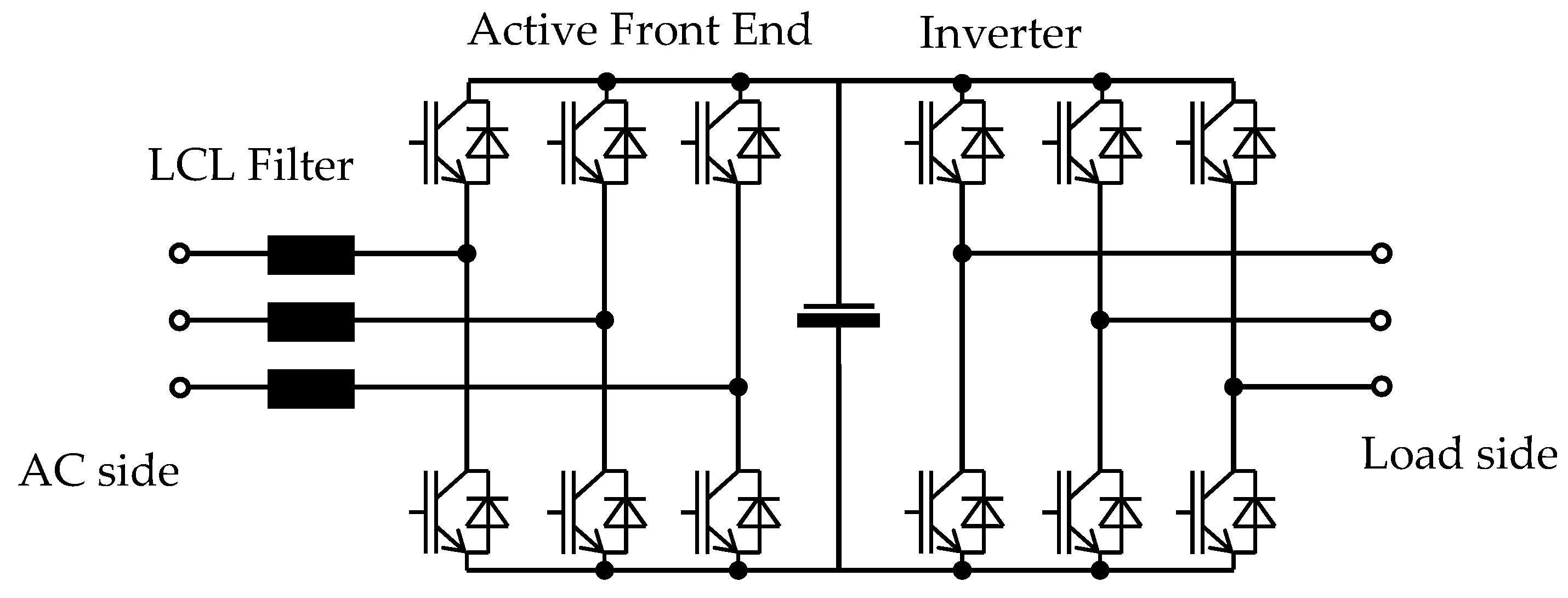
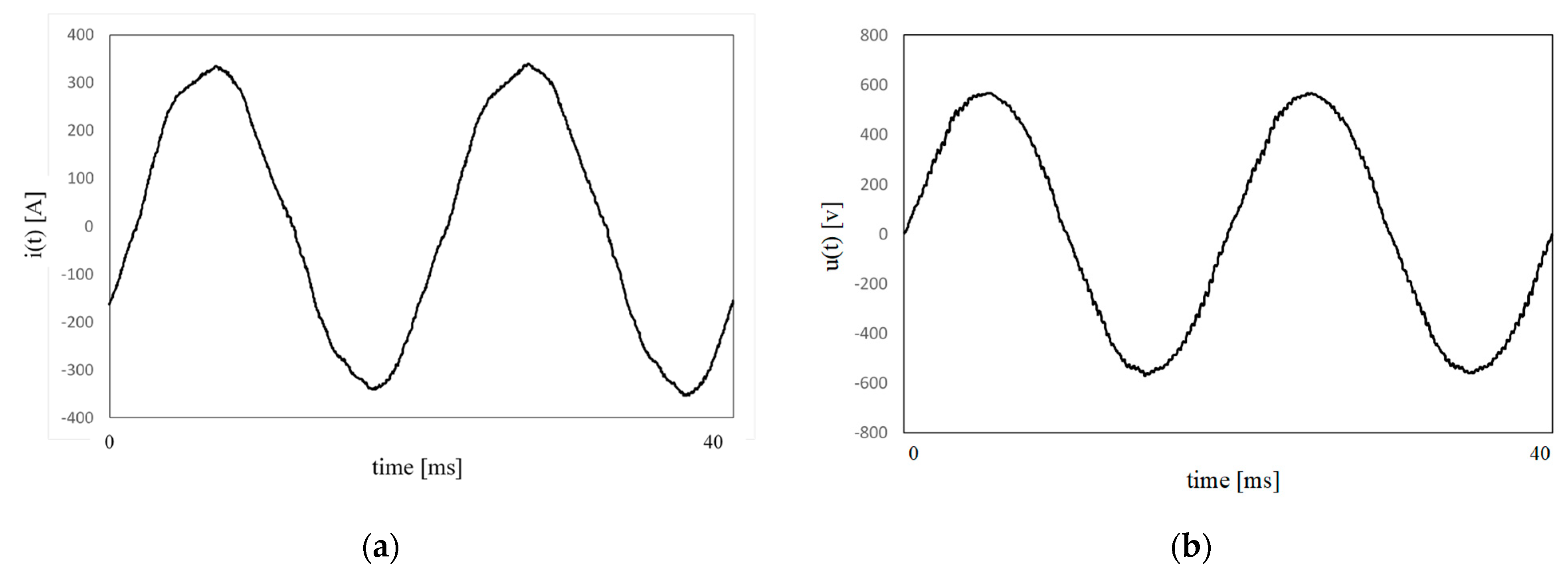
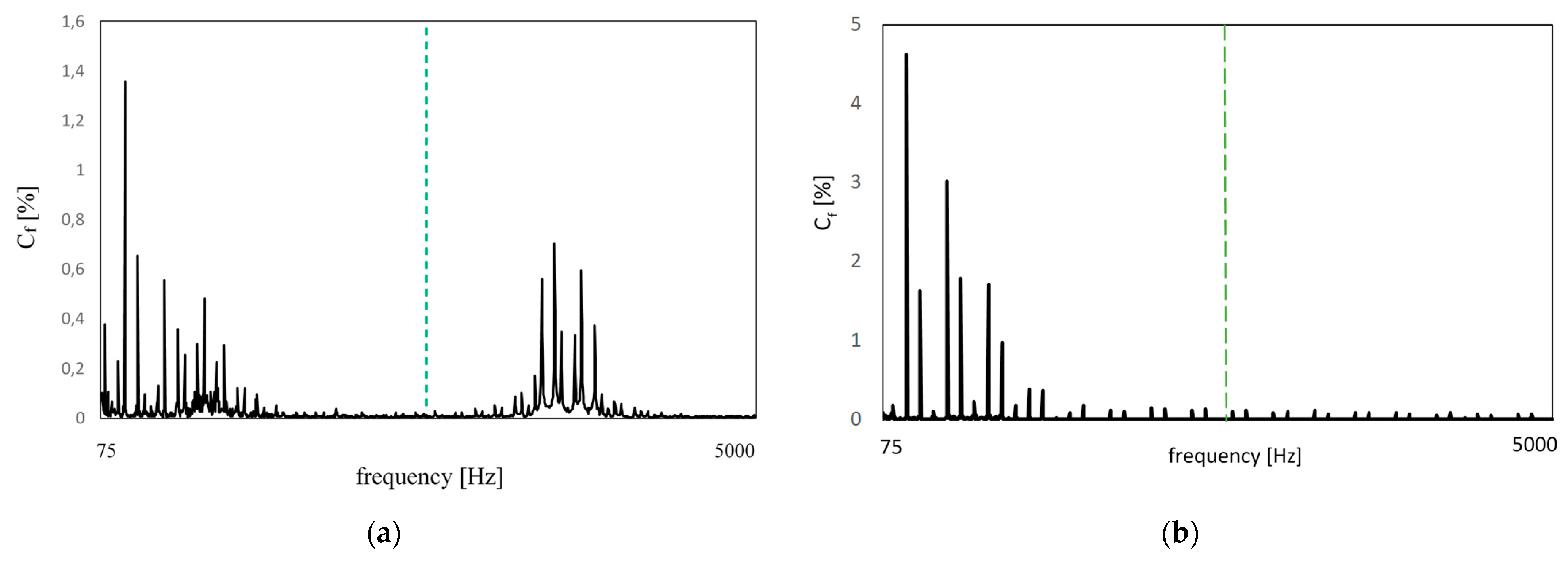
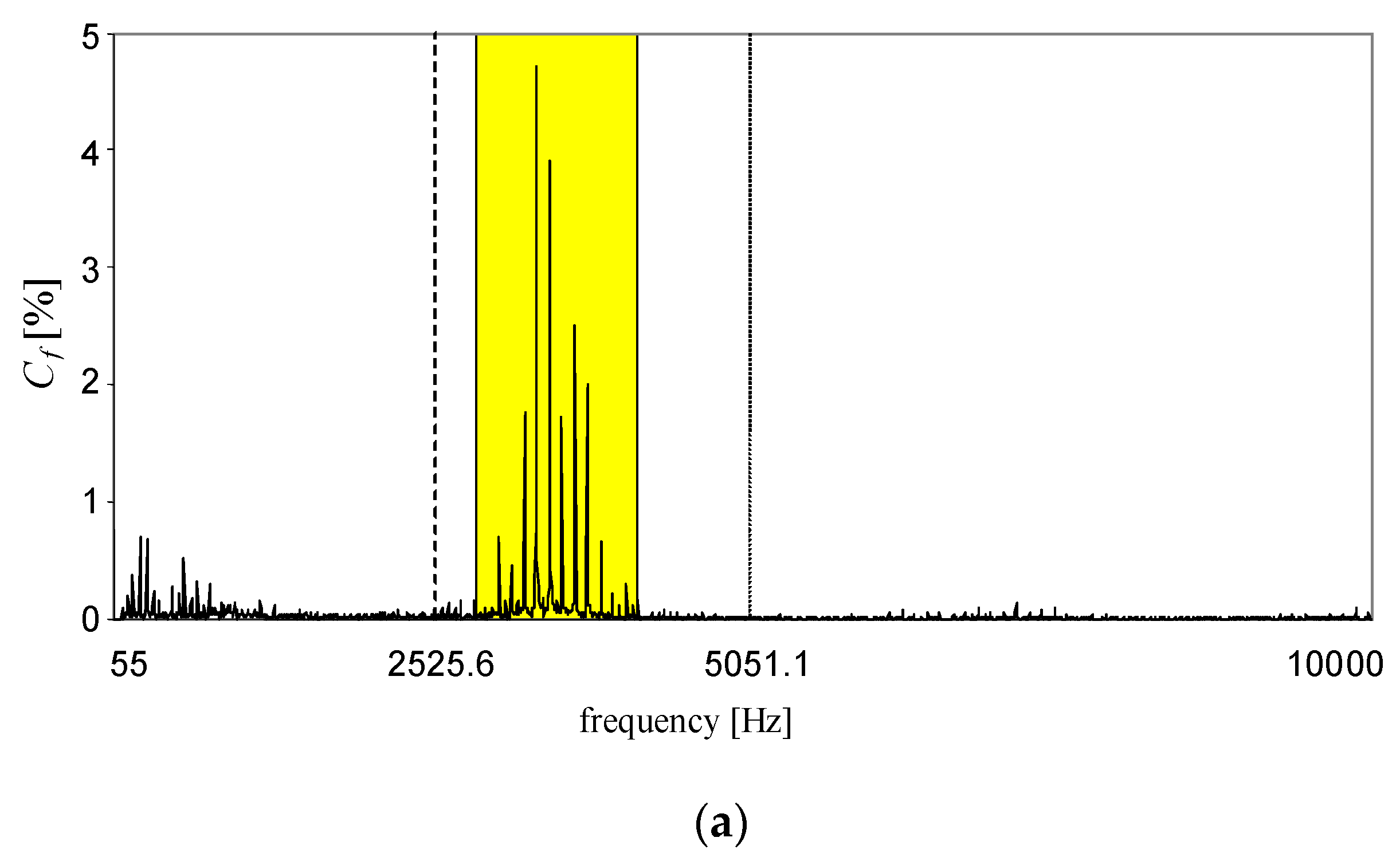


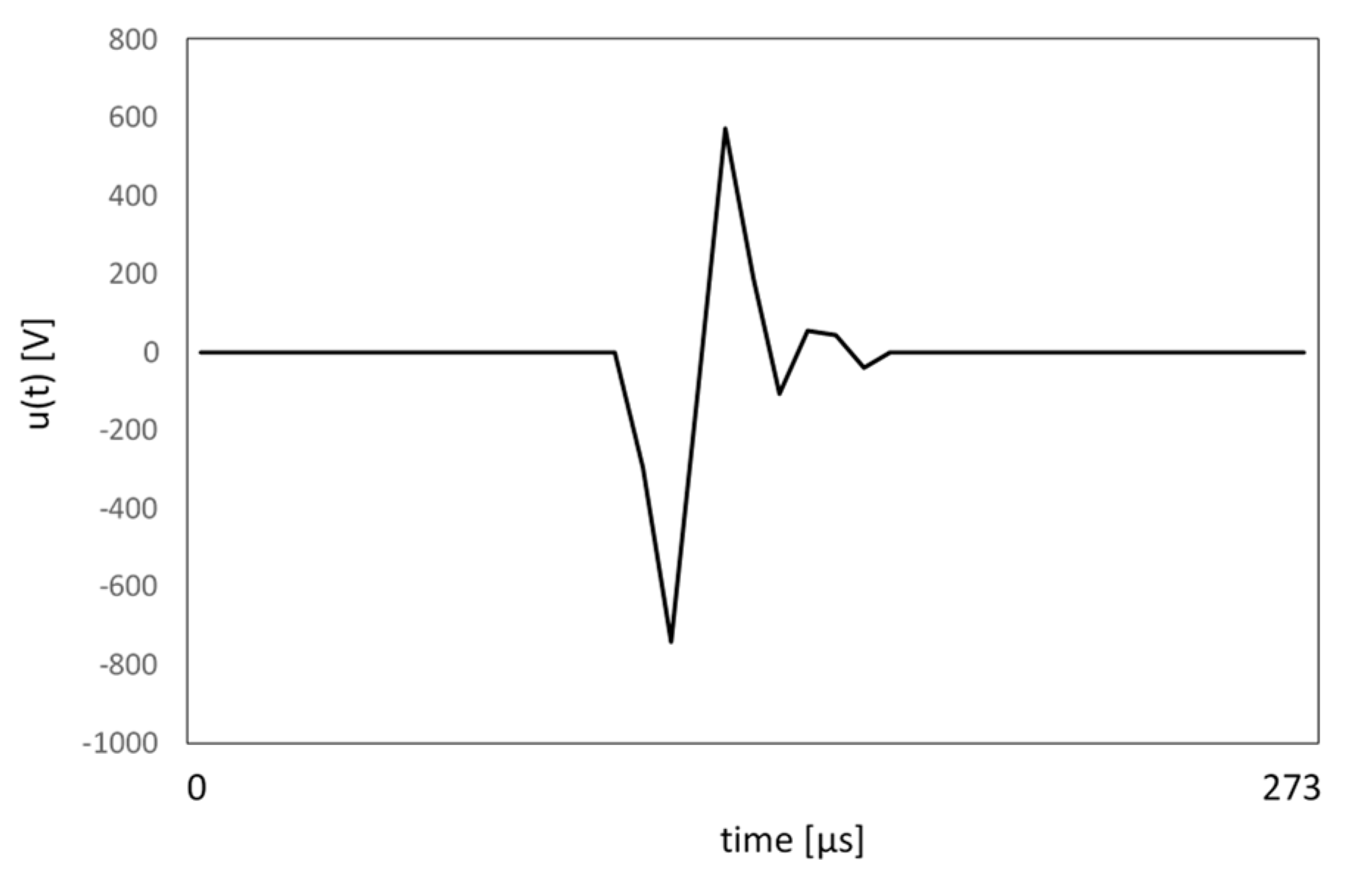
| Case Study | Type and Name of Ship, Year of the Event | Type of Ship Power Plant | Kind of Accident | Accident Reasons | |
|---|---|---|---|---|---|
| Direct | Indirect | ||||
| 1 | Passenger cruise liner, RMS Queen Mary 2, 2010 | Engine room of CODLAG (combined diesel electric and gas turbine), integrated electric propulsion; all-electric ship, 11 kV network | The catastrophic failure of a capacitor in the aft harmonic filter room, and explosion in the aft main switchboard; temporary loss of vessel manoeuvrability | The initial degradation of harmonic filter capacitor construction | A lack of continuous monitoring of electric power quality; shortcomings in ship tests, and operation |
| 2 | Passenger ship, MS Statendam, 2002 | Diesel-electric-generation system cooperating with azipods/propulsion motors; All-electric ship, 6.6 kV network | Arc-flash event in a main circuit breaker, and fire accident in the main switchboard room | Dead short caused the failure of DG2 circuit breaker, causing an explosion and fire in the main switchboard room | A lack of analysis of damage symptoms; a lack of sufficient qualifications of marine engineers, including electricians on-board |
| 3 | Oil platform, Tern Alpha, 2006 | Platform electrical distribution system is based on all-electrical ship system solution. Technical data concerning power generation module are not publicly available | Explosion in the gas compression module, fire, personnel evacuation, stopping of the drilling process | Overheating of a high-voltage electrical motor | High level of distortion in the platform electrical distribution system |
| IACS UR E24 2016/2018 Rules | DNV GL Rules for Ships, 2019 | ||
|---|---|---|---|
| Place of Description | Considered Issue | Place of Description | Way of Implementation |
| Section 1 | Scope To what kind of ship are the requirements of this UR applied? | Part 4, Chapter 8, Section 1, point 2.2 | Documentation related to system design shall be submitted when more than 20% of connected load is by semiconductor assemblies, in relation to connected generating capacity; also required where the electrical distribution system on board a ship includes harmonic filters. In such cases, the effects of a filter failure shall also be calculated. At the same time, in Part 4, Chapter 1, Section 2, point 1.2.8 (c), a related exclusion is placed. Harmonic filters integrated in frequency converters, or installed for single consumers, such as pump motors, may be excluded from these requirements. |
| Section 2 | General The limit of the total harmonic distortion (THD) and possibilities of its relaxation | Part 4, Chapter 8, Section 2, point 1.2.7 | The DNV GL rules concerning the requirements connected with limit values and operation conditions of operating harmonic distortion as well as some recommendations concerning the relaxation conditions are included in Part 4, Chapter 1, Section 2, point 1.2.7: ‘1.2.7 Harmonic distortion (a) Equipment producing transient voltage, frequency and current variations shall not cause malfunction of other equipment on board, neither by conduction, induction or radiation. (b) In distribution systems the acceptance limits for voltage harmonic distortion shall correspond to IEC 61000-2-4 Class 2. In addition, no single order harmonic shall exceed 5%. Guidance note: IEC 61000-2-4 Class 2 implies that the total voltage harmonic distortion shall not exceed 8%.’ Authors’ note: THD is a ratio of the RMS value of the sum of all the harmonic components up to the 50th order to the RMS value of the fundamental component.’ (c) The total harmonic distortion may exceed the values given in (b) under the condition that all consumers and distribution equipment subjected to the increased distortion level have been designed to withstand the actual levels. The system and components ability to withstand the actual levels shall be documented. (d) When filters are used for limitation of harmonic distortion, special precautions shall be taken so that load shedding or tripping of consumers, or phase back of converters, do not cause transient voltages in the system in excess of the requirements in [1.2.4]. Guidance note: the following effects should be considered when designing for higher harmonic distortion, refer to (c): - Additional heat losses in machines, transformers, coils of switchgear and controlgear; - Additional heat losses in capacitors for example in compensated fluorescent lighting; - Resonance effects in the network; - Functioning of instruments and control systems subjected to the distortion; - Distortion of the accuracy of measuring instruments and protective gear (relays); -Interference of electronic equipment of all kinds, for example regulators, communication and control systems, position-finding systems, radar and navigation systems. A declaration or guarantee from system responsible may be an acceptable level of documentation.’ |
| Section 3 | Monitoring of harmonic distortion levels for ships including harmonic filters Subsection 3.1; for new ships, facilities to continuously monitor the levels of harmonic distortion experienced on the busbar as well as alerting the crew should this level exceed acceptable levels | Part 4, Chapter 8, Section 2, point 1.2.8 | Implementation of the related IACS UR concerning continuous power quality monitoring with alarm procedures is directly placed in Part 4, Chapter 1, Section 2, point 1.2.8 (b): ‘Where the electrical distribution system on board a ship includes harmonic filter units, the levels of harmonic distortion experienced on the main busbar shall be continuously monitored. Should the level of harmonic distortion exceed the acceptable limits, an alarm shall be given at a manned location. For ships with class notation E0, the alarm shall be logged.’ |
| Subsection 3.2; for existing ships, as minimum harmonic distortion levels of main busbar are to be measured annually under seagoing conditions as close to the periodical machinery survey. | Part 7, Chapter 1, Section 2, point 3.1.5 | Implementation of the related IACS UR concerning harmonic-distortion-levels control, together with measurement and their records conditions, in reference to existing ships, is in Part 7, Chapter 1, Section 2, point 3.1.5: ‘For electrical installations the survey shall include: - Examination of main source of electrical power with respect to general condition, fire hazard and personnel safety, i.e., generators, main switchboards, distribution boards, control gear, consumers, chargers, and battery/UPS systems. - For all E0, AUT, or AUT-nh vessels (built at any time) and all vessels constructed on or after 1 July, 1998 where electricity is necessary for propulsion and steering, test of automatic start and connection to the switchboard of the standby generator set, shall be carried out. - Where the electrical distribution system on board a ship includes harmonic filters (with exception of pumps’ prime movers): - Harmonic distortion levels of main busbar on board such existing ships shall to be measured annually under seagoing conditions as close to the periodical machinery survey as feasible. Records of all the above measurements shall to be made available to the surveyor. Each measurement shall be taken at maximum distortion levels and identical conditions. Guidance note: This requirement applies for ships contracted for construction before 1 July 2017.’ | |
| Section 4 | Mitigation of the effects of harmonic filter failure on a ship’s operation. The system integrator of the distribution system with harmonic filters is to show, by calculation, the effect of a failure of a harmonic filter on the level of harmonic distortion experienced. The system integrator of the distribution system is to provide the ship owner with guidance documenting permitted modes of electrical distribution system, while maintaining harmonic distortion within acceptable limits during different operation conditions of the system for any combination of harmonic filters. The calculation results and validity of the guidance provided are to be verified by the surveyor during sea trials. | Part 8, Chapter 8, Section 2, point 1.2.8 and point 3.1.3 | Implementation for the related Section of IACS UR is in Part 4, Chapter 1, Section 2, point 1.2.8 (a): ‘Passive and active harmonic filter assemblies/units: (a) Where the electrical distribution system on board a ship includes harmonic filter units, the system integrator of the distribution system shall show, by calculation, the effect of a failure of a harmonic filter unit on the level of harmonic distortion experienced. The system integrator of the distribution system shall provide the ship owner with guidance documenting permitted modes of operation of the electrical distribution system while maintaining harmonic distortion levels within acceptable limits. The system integrator shall also calculate the harmonic distortion that will be experienced in case of a failure of a harmonic filter, and provide guidance on mitigating actions as operating modes or reduced power levels’ This information is also in point 3.1.3: ‘Harmonic distortion (a) All equipment shall be constructed to operate at any load up to the rated load, with a supply voltage containing harmonic distortion as given in Section 2, point 1.2.7.’ |
| Section 5 | Protection arrangements for harmonic filters. Arrangements are to be provided to alert the crew in the event of activation of the protection of a harmonic-filter circuit. The constructional contains as a three-phase unit with individual protection of each phase, as well as the conditions concerning a current unbalance detection system independent of the overcurrent protection alerting the crew. | The references in the DNV GL rules to comply with the related Section 5 of the IACS UR are included in the Chapters 8 and 1, of Parts 4 and 7, respectively. Additionally, the DNV GL rules for ships in some places are cited by the guidance note ‘See IACS UR E24′, and this indicates planned accordance of both documents. | |
| Distortion Factor | Value |
|---|---|
| THD (up to the 50th harmonic) | 1.39% |
| THD (up to the 100th harmonic) | 1.61% |
| TWD (up to the 100th harmonic frequency range) | 8.30% |
| TWD (up to 10 kHz) | 8.37% |
| TWD2.5–10 kHz | 8.22% |
| TIHD (up to the 50th harmonic frequency range) | 0.68% |
| TIHD (up to the 100th harmonic frequency range | 8.14% |
Publisher’s Note: MDPI stays neutral with regard to jurisdictional claims in published maps and institutional affiliations. |
© 2021 by the authors. Licensee MDPI, Basel, Switzerland. This article is an open access article distributed under the terms and conditions of the Creative Commons Attribution (CC BY) license (https://creativecommons.org/licenses/by/4.0/).
Share and Cite
Mindykowski, J.; Tarasiuk, T.; Gnaciński, P. Review of Legal Aspects of Electrical Power Quality in Ship Systems in the Wake of the Novelisation and Implementation of IACS Rules and Requirement. Energies 2021, 14, 3151. https://doi.org/10.3390/en14113151
Mindykowski J, Tarasiuk T, Gnaciński P. Review of Legal Aspects of Electrical Power Quality in Ship Systems in the Wake of the Novelisation and Implementation of IACS Rules and Requirement. Energies. 2021; 14(11):3151. https://doi.org/10.3390/en14113151
Chicago/Turabian StyleMindykowski, Janusz, Tomasz Tarasiuk, and Piotr Gnaciński. 2021. "Review of Legal Aspects of Electrical Power Quality in Ship Systems in the Wake of the Novelisation and Implementation of IACS Rules and Requirement" Energies 14, no. 11: 3151. https://doi.org/10.3390/en14113151
APA StyleMindykowski, J., Tarasiuk, T., & Gnaciński, P. (2021). Review of Legal Aspects of Electrical Power Quality in Ship Systems in the Wake of the Novelisation and Implementation of IACS Rules and Requirement. Energies, 14(11), 3151. https://doi.org/10.3390/en14113151







